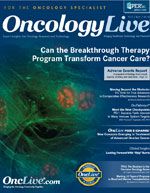Publication
Article
Oncology Live®
Novel Antibody—Drug Conjugate Explored in TNBC
Author(s):
Denise Yardley, MD, and Linda Vahdat, MD, explain the phase III METRIC trial and the potential importance of glembatumumab in triple-negative breast cancer.
Denise Yardley, MD
The phase II METRIC trial is an ongoing randomized trial in triple-negative breast cancer (TNBC) that evaluated the safety and efficacy of the antibody-drug conjugate glembatumumab vedotin (CDX-011).
Glembatumumab targets glycoprotein NMB (gpNMB), which has been associated with reduced metastasis-free and overall survival (OS) after a phase II trial correlated gpNMB expression and response to glembatumumab.
The METRIC trial seeks to compare glembatumumab and capecitabine in 300 women who have gpNMB-positive TNBC. The trial is still in the accrual stages and aims to gain patients based on the level of gpNMB expression, obtained in the advanced, locally advanced, recurrent, or metastatic setting.
The trial has a primary endpoint of progression- free survival (PFS), and final data analysis will occur after 203 PFS events. Currently, about 40% of TNBC, and approximately 20% of breast cancers overall, exhibit overexpression of gpNMB. Overexpression has historically been associated with reduced survival in breast cancer, small cell lung cancer, and glioblastoma.
Q: What are the goals of the ongoing METRIC study?
Both Denise Yardley, MD, a medical oncologist at the Sarah Cannon Cancer Research Institute in Nashville, Tennessee, and Linda Vahdat, MD, professor of Medicine, director of the Breast Cancer Research Program and chief of the Solid Tumor Service, Weill Cornell Medical sat down with OncologyLive, to further explain the phase III METRIC trial and the potential importance of glembatumumab in TNBC.Dr Yardley: The METRIC study was a follow- up study to the EMERGE trial. This trial evaluated glembatumumab against a panel of different treatment options to determine activity in the TNBC population against investigator’s choice of an agent. Median PFS was 3.5 months and OS was 10 months in the glembatumumab arm, compared with 1.5 months and 5 months, respectively, in the investigator’s choice arm.
Q: Why was capecitabine chosen as the control arm?
Q: This trial is ongoing. What is its current status?
Q: What is the mechanism of action for glembatumumab?
Q: What toxicities were seen with this drug?
Q: What could be the impact of this drug in the future?
The METRIC trial consists of a less heavily pretreated population. Patients can have up to two prior medications and have to have received taxane and anthracycline. All patients have to demonstrate gpNMB expression. That trial is ongoing, and hopefully we’ll be able to replicate the strong signal from the EMERGE trial.When we were trying to look at the taxane and anthracycline pretreated patient population, which is a stipulation of the trial, and we were looking at a drug that had an indication in metastatic breast cancer in up to 2 prior lines of therapy, capecitabine really emerged as a drug that’s frequently used in that setting and has that FDA-labeled indication.The trial is continuing accrual and, now that we’ve been able to add prescreening and identify patients by the gpNMB expression, we’ve made some modifications using the definition of triple-negative with the hormone receptor positivity as less than 10%. I think accrual has really picked up and has gotten on to a lot of different radars and has had a lot of publicity. It’s now not quite halfway accrued, but a good start toward that.Dr Vahdat: Glembatumumab vedotin is an antibody— drug conjugate. The antibody part of it targets gpNMB, also known as osteoactivan, and that is very important for cell migration and invasion. It is linked to a drug called monomethyl auristatin, which is an anti-microtubular drug. The important thing about this is that it delivers the drug directly to the tumor, and that is important for certain types of chemotherapy drugs that are too toxic to give by vein. With antibody–drug conjugates, generally speaking you can deliver a much higher dose of drug to the tumor than you normally would be able to. The hope is that, if you can deliver the drug directly to the tumor, you can kill more cancer cells.It is a fairly well tolerated drug. Side effects include lower blood counts, which is probably related to the chemotherapy part of the antibody— drug conjugate. Patients can develop a rash because gpNMB expression can occur in the skin. On occasion, there is a low incidence of peripheral neuropathy; I would say in the single digits, but probably below 5%.If glembatumumab vedotin is able to show benefit in gpNMB-overexpressing breast cancer, then it would be the first targeted treatment for TNBC. That would be huge, because there are none out there right now. There is no standard treatment for patients who have TNBC. There are many agents that have activity, but there is no direction that we are pointed in, in terms of what is the optimal sequencing. TNBC is a very challenging issue not only for patients, but also for clinicians.































%20(2)%201-Recovered-Recovered-Recovered-Recovered-Recovered-Recovered-Recovered-Recovered-Recovered-Recovered-Recovered-Recovered-Recovered-Recovered-Recovered-Recovered-Recovered.jpg?fit=crop&auto=format)
%20(2)%201-Recovered-Recovered-Recovered-Recovered-Recovered-Recovered-Recovered-Recovered-Recovered-Recovered-Recovered-Recovered-Recovered-Recovered-Recovered-Recovered-Recovered.jpg?fit=crop&auto=format)
